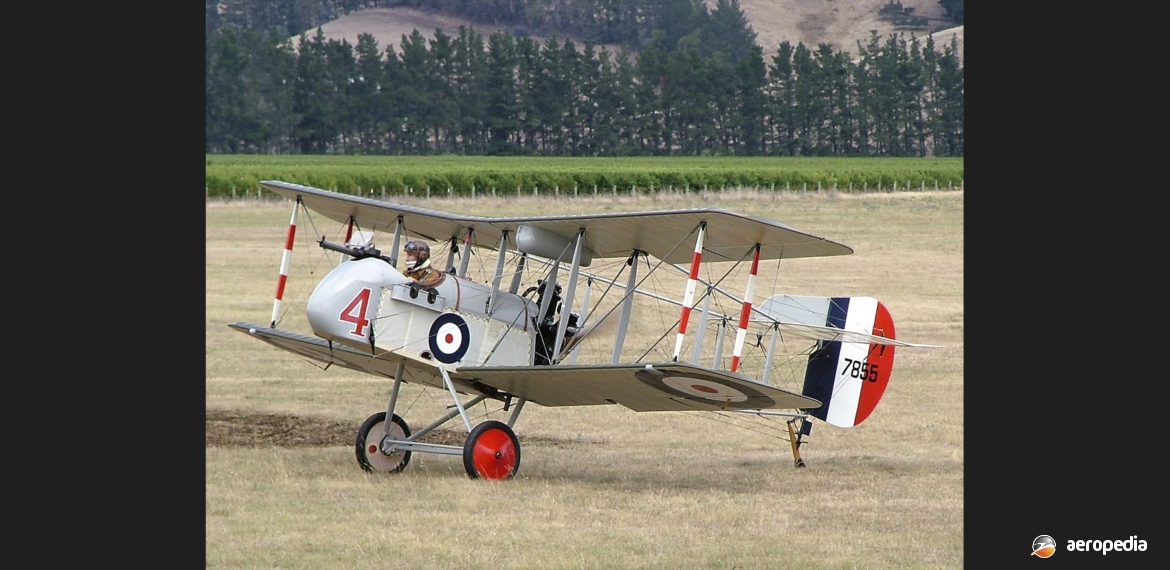Photograph:
de Havilland DH.2 replica ZK-JOH (c/n 100) at Omaka, New Zealand in April 2003 (David C Eyre)
Country of origin:
United Kingdom
Description:
Single-seat fighter aircraft
Power Plant:
One 75 kw (100 hp) Gnome Monosoupape nine-cylinder rotary piston engine
Specifications:
- Wingspan: 8.62 m (28 ft 3 in)
- Length: 7.68 m (25 ft 2½ in)
- Height: 2.92 m (9 ft 2½ in)
- Wing area: 23.13 m² (249 sq ft)
- Max speed at sea level: 150 km/h (93 mph)
- Max speed at 1,524 m (5,000 ft): 145 km/h (90 mph)
- Max speed at 3,048 m (10,000 ft): 124 km/h (77 mph)
- Climb to 1,524 m (5,000 ft): 8 mins 25 sec
- Time to 3,048 m (10,000 ft): 24 mins 45 sec
- Service ceiling: 4,267 m (14,000 ft)
- Endurance: 2¾ hours
- Empty weight: 428 kg (943 lb)
- Military load: 91 kg (200 lb)
- Loaded weight: 654 kg (1,441 lb)
Armament:
One 7.7 mm (0.303 in) Lewis machine-gun in front cockpit
History:
After working with the Royal Aircraft Factory for a period, in 1914 Geoffrey de Havilland moved to the Aircraft Manufacturing Company Ltd [Airco] and commenced to design aircraft. His first design became known as the Airco DH.1 and was a reconnaissance machine. Because of the lack of an interrupter gear to prevent bullets hitting the propeller, in his next design, the DH.2, he placed the engine behind the pilot, thus providing un interrupted fire forward. Designed in 1915, the DH.2 was a two-bay biplane armed with a Lewis machine-gun, the prototype (serial 4732) being sent to France in July 1915 and commencing operations with No 5 Squadron RFC but is believed to have been shot down.
The DH.2 was placed in production and initial deliveries went to No 24 Squadron RFC, at this time the Lewis machine-gun being installed as a completely free weapon. However, this was modified and the pilot’s windscreen was attached to the machine-gun. Ammunition drums were carried on external racks on each side of the cockpit. Standard engine was the Gnome Monosoupape but consideration was given at one stage to the fitting of the 82 kw (110 hp) Le Rhone, one aircraft being fitted with this and tested. The type was not popular in service, being very demanding, and a number were lost in spinning accidents due to the ease with which it entered a spin.
However, the aircraft was very strong, fully aerobatic and sensitive on the controls, being recognised as pleasant to fly. Eventually the Lewis machine-gun was fixed to fire forward along the line of flight. On 1 July 1916 Major L W B Rees, officer commanding No 32 Squadron, in a DH.2 (serial 6015) won the Victoria Cross [VC] after single-handedly fighting against ten enemy two-seat fighters. On 20 July 1916 four DH.2s fought against 11 enemy aircraft over Flers in France and shot down two.
The DH.2 became obsolete in 1916 as compared to opposing aircraft, this being shown on 23 November 1916 when Major Lanoe George Hawker, commanding officer of No 24 Squadron, in a DH.2 (serial 5964) was shot down by Manfred Von Richthofen in an Albatros D.II.
A total of 400 examples was built, of which 266 went to France where they formed the equipment of Nos 24, 29 and 32 Squadrons RFC. The DH.2 scored many combat successes. However, by the time the Albatros and Halberstadt fighters appeared on the front, the DH.2 was no longer able to match enemy aircraft and was replaced by the de Havilland DH.5. A few continued in service in Palestine and Macedonia but most were relegated to training duties.
No DH.2 has survived but a couple of replicas have been built. One was operated as G-BFVH / 5964 in the United Kingdom for a period. It was built by Vivian Bellamy for Leisure Sport Ltd and was fitted with a Pobjoy Niagara Mk 3 radial engine. Another was completed in the United States as N32DH.
One joined the collection of World War I aircraft at Omaka in New Zealand, was airworthy and was registered as ZK-JOH (c/n 100). This machine was built in the United States by Walter Redfern and was fitted with a 93 kw (125 hp) Kinner radial engine. It was flown at a number of aviation events in the Omaka area and around Blenheim in 2003 before it was placed on display in the Aviation Heritage Centre.
In the United States members of the Experimental Aircraft Association Chapter 292 (EAA) commenced construction of five examples of the DH.2 in Oregon. When nearing completion three were exported to New Zealand where work commenced to complete them to airworthiness at Omaka in 2020. Work continued on the other two in Oregon, one being completed and flown in 2019.

